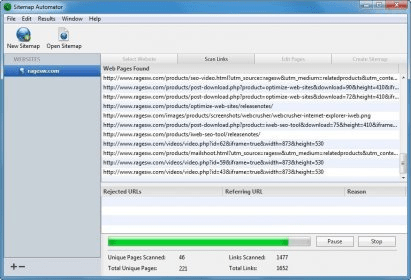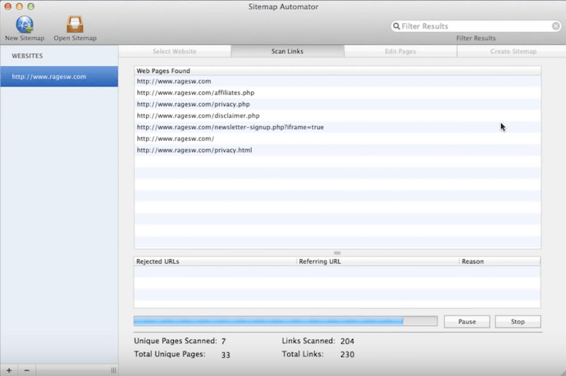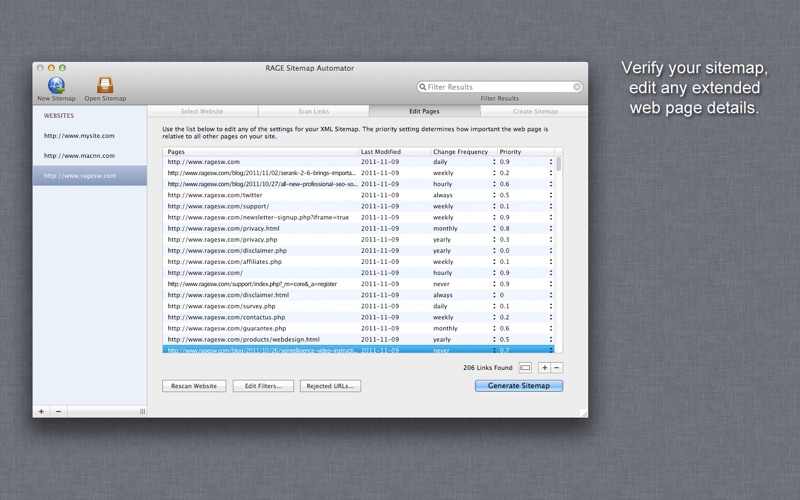Free Online Google Sitemap Generator. XML-sitemaps.com provides free online sitemap generator service, creating an XML sitemap that can be submitted to Google, Bing and other search engines to help them crawl your website better. It will also generate an HTML site map. After you have downloaded the file, back in Sitemap Automator, click on file in the menubar and select Publish Verification File. Then click on the Select Verification File and find the file that you just downloaded. The next step is to publish the file by either publishing to FTP or publishing to iDisk. Sitemap Automator makes it so easy to create XML Sitemap files that tell search engines all about your website including which pages to index, how often to come back for fresh, new content, and how important each page on your website is. How to check to see if you published your XML Sitemap correctly. To explore the Automator User Guide, click Table of Contents at the top of the page, or enter a word or phrase in the search field.
You can use a command line interface to automate all the major sitemap generator tools in the program.

Rage Sitemap Automator
This means that you can also use external applications and bat / batch / script files.
 This enables you to run our sitemap generator software at regular intervals using e.g. Windows Task Scheduler.
This enables you to run our sitemap generator software at regular intervals using e.g. Windows Task Scheduler. - Parameters:
- ':%project-path%' : Where %project-path% should contain the active project file path. (Remember the colon before project path.)
- '@override_initfromproject=c:exampleprojectsinitfrom.ini@' : Overwrite the initial project settings used.
- '@override_rootpath=http://example.com@' : Overwrite website rootpath.
- '-autocreate' : Automatically create project files and related if they do not exist already.
- '-exit' : Exits when done.
- '-hide' : Always invisible and exits when done.
- '-scan' : Runs website scanner.
- '-stop0000' : Stops scan after a number of seconds, e.g. -stop600 stops scan after 10 minutes.
- '-save' : Saves project.
- '@override_exportpathdir=c:exampleexports@' : Overwrite general directory path used for e.g. CSV export data files.
- '-exportexternalcsv' : Exports all URLs data listed in 'external' tree view into a file called 'external.csv' located in project directory.
- '-exportinternalcsv' : Exports all URLs data listed in 'internal' tree view into a file called 'internal.csv' located in project directory.
- '-exportsitemapcsv' : Exports all URLs data listed in 'internal' tree view into a file called 'sitemap.csv' located in project directory.
- '@override_sitemapxmlpath=c:examplesitemap.xml@' : Overwrite where the generated XML sitemap files are stored.
- '-buildxml' : Runs sitemap builder and creates XML sitemap.
- '-buildnewsxml' : Runs sitemap builder and creates XML news sitemap.
- '-buildmobilexml' : Runs sitemap builder and creates XML mobile sitemap.
- '-buildvideoxml' : Runs sitemap builder and creates XML video sitemap.
- '-buildimagexml' : Runs sitemap builder and creates XML image sitemap.
- '-buildcodexml' : Runs sitemap builder and creates XML code sitemap.
- '-buildrss' : Runs sitemap builder and creates RSS sitemap.
- '-buildtext' : Runs sitemap builder and creates text sitemap.
- '-buildtemplate' : Runs sitemap builder and creates template sitemap (usually HTML / XHTML).
- '-buildaspnet' : Runs sitemap builder and creates XML ASP.Net sitemap for use by ASP.Net controls.
- '-buildgraphdatadot' : Build a graph data file using dot / .gv file format which can visualized in other tools including GraphViz.
- '-build' : Runs sitemap builder and creates a sitemap of the selected type in project settings.
- '-buildall' : Runs sitemap builder for all kinds.
- '-robotstxt' : Creates a 'robots.txt' file.
- '-upload' : Runs sitemap uploader and FTP uploads the last generated sitemap.
- '-uploadall' : Runs sitemap uploader and FTP uploads all generated sitemaps.
- '-ping' : Performs sitemap ping notification.
- Examples for usage on Windows:
- [ 'c:microsyssitemapSitemap.exe' -exit -scan -build -upload -save ':c:microsyssitemapprojectsmy-project.ini' ].
- [ 'Sitemap.exe' -exit -scan -build -upload -save ':my-project.ini' ] - Here it is assumed my-project.ini is in the same directory as the executable.
- [ 'Sitemap.exe' -scan -build @override_rootpath=http://example.com@ ]
- [ start ' 'Sitemap.exe' -scan -build @override_rootpath=http://example.com@ ] - Launches asynchronously. Do not use spaces in parameters.
[ timeout 2 ] - Idle time to avoid problems with multiple instances launching at the exact same time.
- Examples for usage on Mac OS:
- [ open -n A1SitemapGenerator.app --args -scan -build @override_rootpath=http://example.com@ ].
- [ open -n A1SitemapGenerator.app --args -exit -scan -build -save -autocreate ':/users/%name%/myprojects/shopexample.ini' @override_initfromproject=/users/%name%/myprojecs/mydefaults.ini@ @override_rootpath=https://shop.example.com@ ].
- Tips:
- To prevent a parameter value that contains spaces (e.g. if you are passing a directory path) from being broken up, enclose it inside a couple of '.
- In the above examples
%name%refers to your user name in the given operating system.
Sitemap Automator : How To Create & Publish An XML Sitemap
October 13th, 2011The video tutorial below will show you the basics of creating an XML Sitemap using Sitemap Automator. We will also cover the basic points of publishing your Sitemap to your server.
Video Transcript:
To create an XML Sitemap using Sitemap Automator, the first thing you must do is add your site’s URL by clicking the New Sitemap button, and typing in your URL. Pay close attention to make sure there are no mistakes in your URL such as seeing http more than once.

Then click on the Create Sitemap button. Sitemap Automator will now scan through your website and find all of the available internal links on your site. When it is done you will be able to see all of the links that it was able to find.
Your next step is to click the Generate Sitemap button.
Now we must publish this Sitemap to our server. From the drop down menu, select to publish either to your iDisk or to your FTP server, and then press the Publish button.
Sitemap Automator

Sitemap Automator
If you publish to iDisk, your publish window will look like this. Select the option to publish to the root folder if you only have one website on your MobileMe account. If you have more than one, select the option to publish to selected website, and then select the website that you want to publish the Sitemap to, and then press the Publish button.
If you publish to FTP, your publish window will look like this. Enter your FTP login details in each of the fields. The Server field is usually just your website’s URL without the http, or www. If you are unsure of what your username, password, or root directory path may be, you will need to contact your web host to find out. When you are finished filling all the fields out, press the Upload button.
Your Sitemap should now be live on your site.
Remember to subscribe and visit our site for the next steps in our Sitemap Automator Instructional series.
Related posts you may be interested in:
